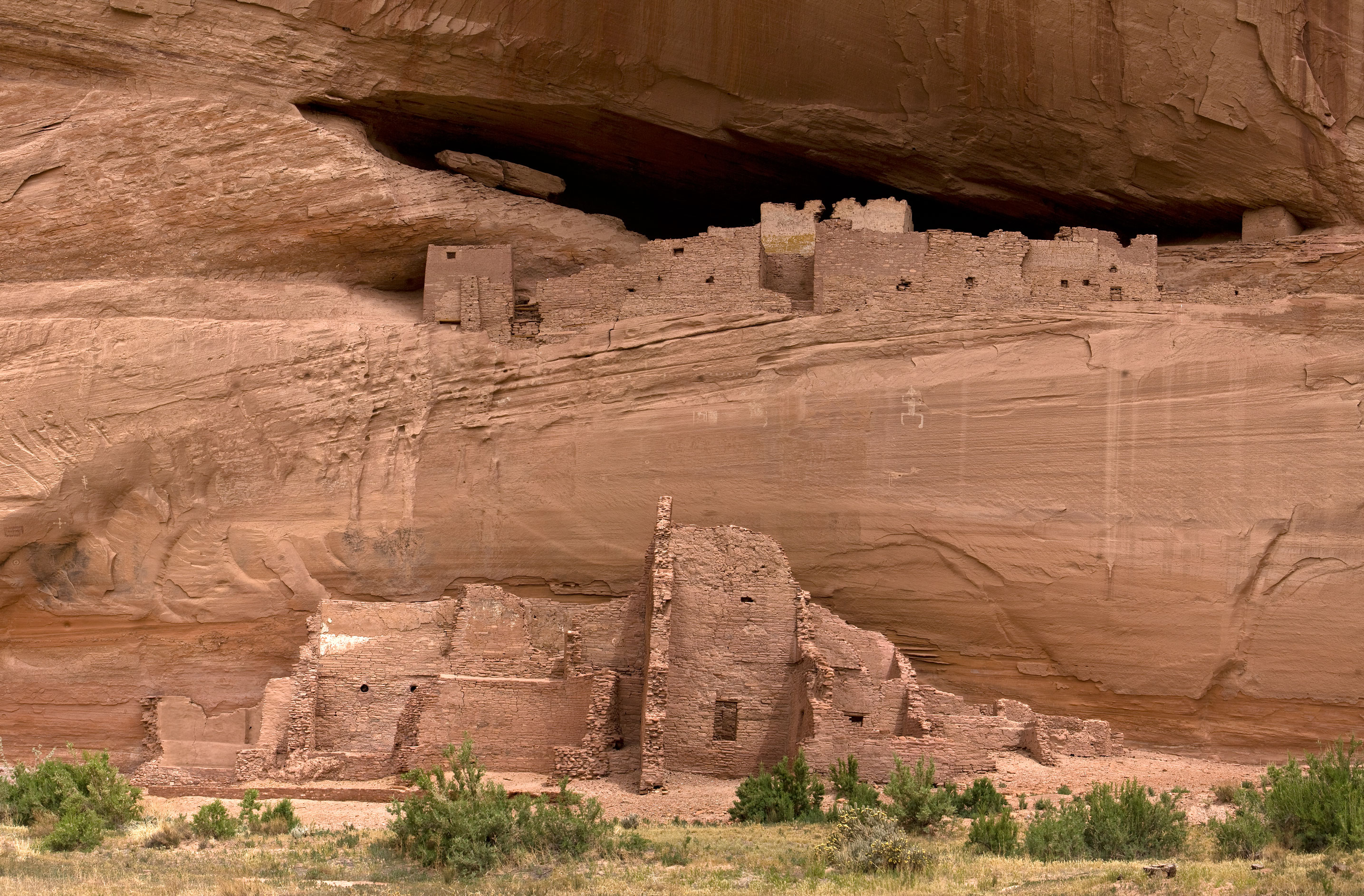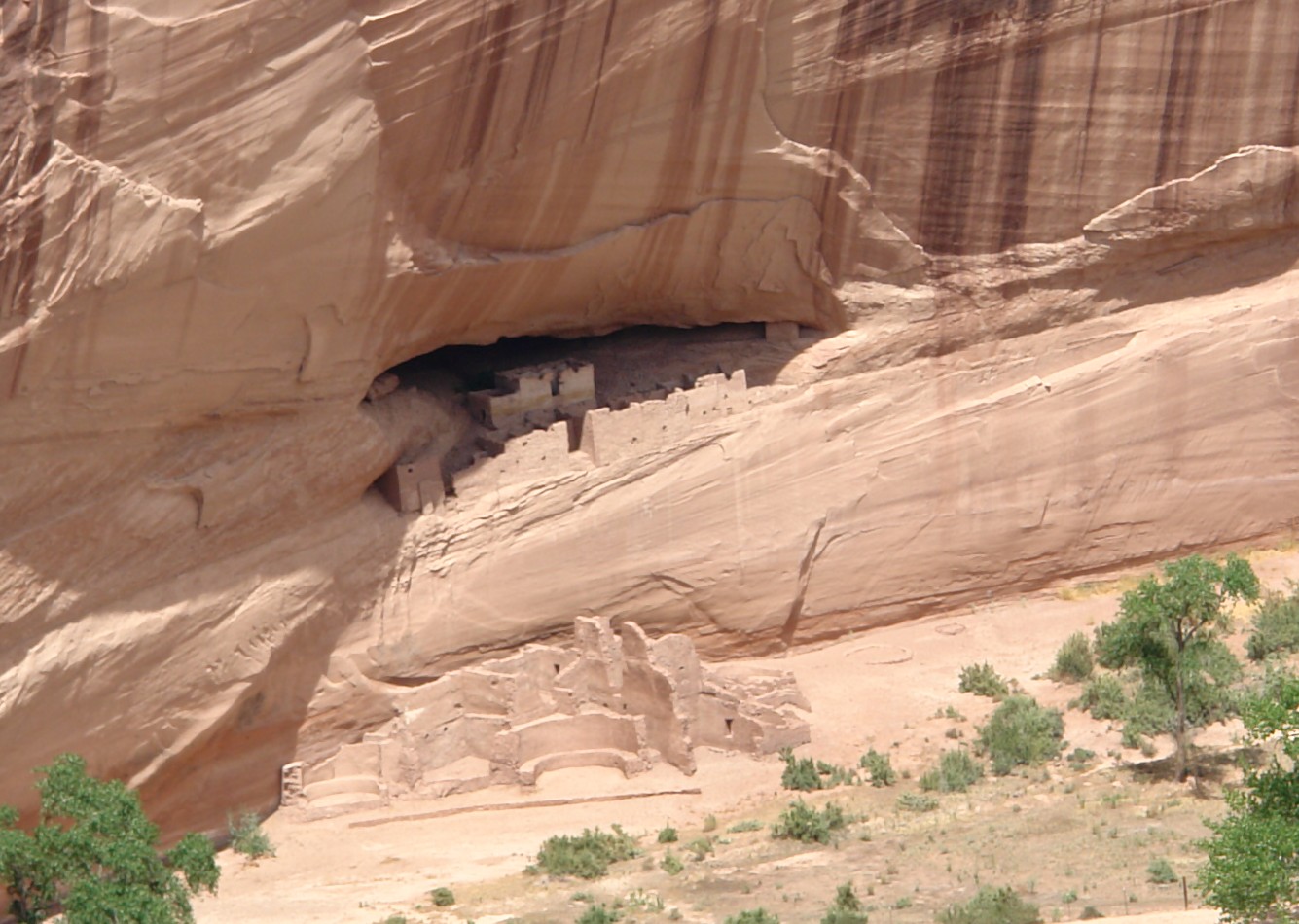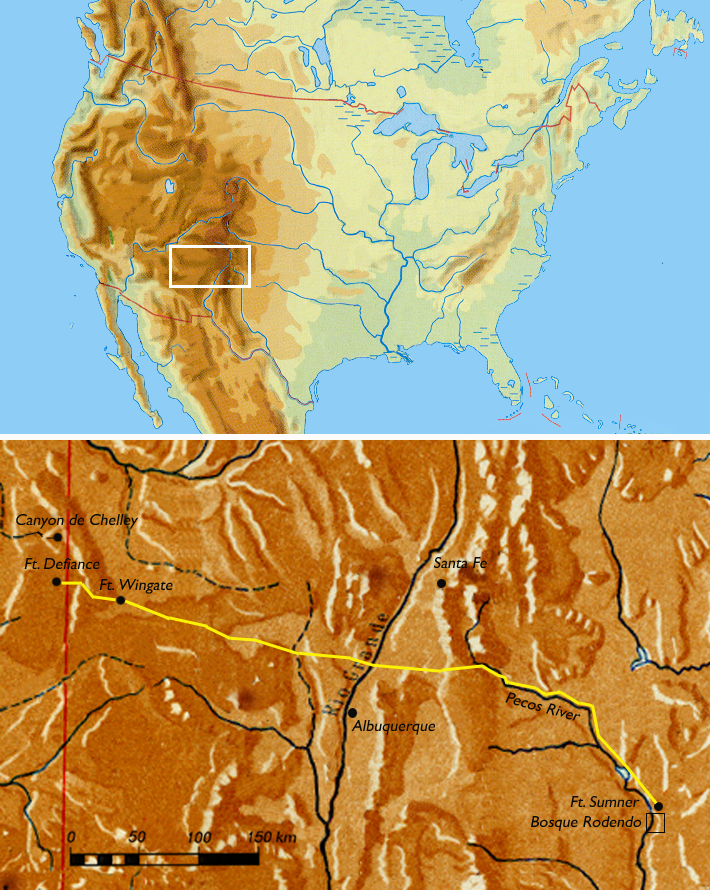.

White House ruins, Canyon de Chelly National Monument: photo by Cacophony, 3 May 2009
The name "Anasazi" has come to mean "ancient people," although the word itself is Navajo, meaning "enemy ancestors." [The Navajo word is anaasází (<anaa- "enemy", sází "ancestor").] The term was first applied to ruins of the Mesa Verde by Richard Wetherill, a rancher and trader who, in 1888–1889, was the first Anglo-American to explore the sites in that area. Wetherill knew and worked with Navajos and understood what the word meant. The name was further sanctioned in archaeology when it was adopted by Alfred V. Kidder, the acknowledged dean of Southwestern Archaeology. Kidder felt that it was less cumbersome than a more technical term he might have used. Subsequently some archaeologists who would try to change the term have worried that because the Pueblos speak different languages, there are different words for "ancestor," and using one might be offensive to people speaking other languages.
-- Linda Cordell: Ancient Pueblo Peoples, 1994

View from river valley, Canyon de Chelly National Monument: photo by Ansel Adams, 1942 (US National Archives and Records Administration)

White House Ruins in Canyon de Chelly National Monument, near Chinle, Arizona, built c. 1200 by the Anasazi, a Navajo word meaning the Ancient Ones: photo by Greg Peterson 2009
D. H. Lawrence: Ghosts (Men in New Mexico)
Mountains blanket-wrapped
Round a white hearth of desert --
While the sun goes round
And round and round the desert,
The mountains never get up and walk about.
They can't, they can't wake.
They camped and went to sleep
In the last twilight
Of Indian gods;
And they can't wake.
Indians dance and run and stamp --
No good.
White men make gold-mines and the mountains un-make them
In their sleep.
The Indians laugh in their sleep
From fear,
Like a man when he sleeps and his sleep is over, and he can't wake up,
And he lies like a log and screams and his scream is silent
Because his body can't wake up;
So he laughs from fear, pure fear, in the grip of the sleep.
A dark membrane over the will, holding the man down
Even when his mind has flickered awake;
A membrane of sleep, like a black blanket.
We walk in our sleep, in this land,
Somnambulist wide-eyed afraid.
We scream for someone to wake us
And our scream is soundless in the paralysis of sleep,
And we know it.
The Penitentes lash themselves till they run with blood
In their efforts to come awake for one moment;
To tear the membrane of this sleep...
No good.
The Indians thought the white men would awake them...
And instead, the white men scramble asleep in the mountains,
And ride on horseback asleep forever through the desert,
And shoot one another, amazed and mad with somnambulism,
Thinking death will awaken something...
No good.
Born with a caul,
A black membrane over the face,
And unable to tear it,
Though the mind is awake.
Mountains blanket-wrapped
Round the ash-white hearth of the desert;
And though the sun leaps like a thing unleashed in the sky
They can't get up, they are under the blanket.

Antelope Ruin, Cañon del Muerto -- Navaho: photo by Edward S. Curtis, c. 1907 (Edward S. Curtis Collection, Library of Congress)

The cliffs, Canyon de Chelly, Arizona: photo by Edward S. Curtis, c. 1905 (Edward S. Curtis Collection, Library of Congress)

Cañon de Chelle, Arizona. Walls of the Grand Canyon about 1200 feet: photo by Timothy H. O'Sullivan, from the 1873 U.S. Army Corps of Engineers Geographical Exploration and Surveying Expedition West of the 100th Meridian (Library of Congress)
James Henry Carleton: Letter recommending removal of the Navajo to Bosque Redondo (1863)
Head Quarters, Department of New Mexico
Santa Fé, N.M. September 6, 1863
Brig. General Lorenzo Thomas,
..... Adjutant General U.S.A.
........... Washington, D.C.
General,
I have the honor to report that I have this week sent fifty one Navajoe Indian men, women, and children to Fort Sumner, at the Bosque Redondo on the Pecos River, where, as I have before informed you, I have four hundred and twenty-five Mescalero Apaches, held as prisoners. The purpose had in view is to send all captured Navahoes and Apaches to that point, and there to feed and take care of them until they have opened farms and become able to support themselves, as the Pueblo Indians of New Mexico are doing. The War Department has already approved of this in the case of the Apaches, and authorized that Fort Sumner should be a chaplain post, so that the chaplain there could educate the Indian children. This year those Indians have been contented and happy. They planted under the direction of their agent and with a little help -- some large fields of corn -- and now that they have their acequia dug, will next year raise quite enough to support themselves. This the Navajoes can be persuaded to do as well.
At the Bosque Redondo there is arable land for all the Indians of this family: (The Navajoes and Apaches have descended from the same stock and speak the same languages.) and I would respectfully recommend, that now the war is vigorously prosecuted against the Navahoes -- that the only peace that can ever be made with them must rest on the basis that they move onto these land[s], and like the Pueblos become an agricultural people, and cease to be nomads. This should be a sine qua non. As soon as the snows of winter admonish them of the suffering to which their families will be exposed -- I have great hopes of getting most of the tribe. The knowledge of the perfidy of these Navajoes, gained after two centuries of experience, is such as to lead us to put no faith in their promises. They have no government to make treaties. They are a patriarchal people. On[e] set of families may make promises, but the other set will not heed them. They understand the direct application of force as a law. If its application be removed, that moment they become lawless. This has been tried over and over and over again, and at great expense. The purpose now is never to relax the application of force with a people that can no more be trusted than you can trust the wolves that run through their mountains. To gather them together little by little onto a Reservation away from the haunts and hills and hiding places of their country, and there be kind to them: there teach their children how to read and write: teach them the art of peace: teach them the truths of christianity. Soon they will acquire new habits, new ideas new modes of life: the old Indians will die off and carry with them all latent longings for murdering and robbing: the young ones will take their places without these longings: and thus, little by little, they will become a happy and contented people, and Navajoe Wars will be remembered only as something that belongs entirely to the Past. Even until they can raise enough to be self-sustaining -- you can feed them cheaper than you can fight them.
You will observe that the Bozque Redondo is far down the Pecos on the open plains -- where those Indians can have no lateral contact with settlers. If the government will only set apart a reservation of forty miles square, with Fort Sumner at the Bosque Redondo in the centre, all the good land will be covered, and keep the settlers a proper distance from the Indians. See the enclosed map. There is no place in the Navajoe Country fit for a Reservation: and even if there were, it would not be wise to have it there: for little by little the Indians would steal away into their mountain fastnessess again -- and then as of old, would come a new war, and so on, ad infinitum.
I know these views are practical -- practicable -- and humane: -- are just to the suffering people, as well as to the aggressive, perfidious, butchering Navahoes. If I can one more full regiment of cavalry and authority to raise one independent company in each county in the Territory -- they can soon be carried to a final result.
I am, General,
....... Respect[f]ully,
........... Your obt. servant.
...................... JJames H. Carleson.
..............................
Commanding.

The white house, Canyon de Chelly, Arizona: photographer unknown (Navaho Tours), 1922 (U.S. Geography File, Library of Congress)

The white house, Canyon de Chelly, Arizona: photographer unknown (Navaho Tours), 1922 (U.S. Geography File, Library of Congress)
1858. Manuelito, a "rico" Navajo Chiefta[i]n, found 60 head of his livestock shot by U.S. soldiers. Furious, he confronted the Major at Fort Defiance and told him the water and the grass belonged to him and his people, not to the U.S. Army. Soldiers from Fort Defiance, supported by 160 Zuni mercenaries, burned Manuelito's village and fields. Manuelito resolved to drive the white soldiers off their lands and began organizing other Navajo Chiefta[i]ns and Headmen for war.
1860. Navajos attack Fort Defiance. Over 1,000 Navajos led by Manuelito, a wealthy headman, and Barboncito, a medicine man and war leader, attacked Fort Defiance. They almost completely overran it, until superior gunfire drove them off. This marked the beginning of the U.S. Army's policy of "total war" against the Navajos. Although the outbreak of the Civil War the following year caused the withdrawal of the soldiers and the abandonment of Fort Defiance, the Navajo war was taken up by the new commander in Santa Fe, James Carleton. The Navajos, like the Apaches, were considered a grave threat to the Army of the West.
1863. New Mexico was cut in half, to create the Territory of Arizona.
1863 to 1864. The U.S. war against the Navajo Tribe. The Navajo Long Walk, and imprisonment at Bosque Redondo. Kit Carson drove the Navajo from their lands by destroying their means of survival using his "Scorch[ed] Earth Policy". His U.S. Army killed the sheep, goats, and horses, poisoned wells, burned orchards and crops, destroyed hogans and livestock shelters, and anything else that was of value to the Navajo. Manuelito, Barboncito, Ganado Mucho, and other headmen retreated into the most remote Navajo lands. Thousand of others went into hiding in the deep recesses of Canyon de Chelly, previously unexplored by white men and noted for its quicksand floor. By winter Carson's men set up a blockade at the entrance to the canyon, shot anyone trying to leave, and in March rounded up thousands of starving Navajo and sent them on the "Long Walk" to Fort Sumner at Bosque Redondo, New Mexico. More than 8,000 Navajos, as well as some Mescalero Apache who had not fled south, were marched 350 miles through spring blizzards from Fort Defiance to Fort Sumner. Many of the Apaches fled to Mexico rather than be captured. The soldiers shot anyone moving too slowly, raped women, and shot the elderly. (Oral histories of the Navajo recount that when they asked the soldiers to stop so a pregnant woman could give birth, the soldiers refused. "Not long after [we] moved on, we heard a gun-shot ...") Many froze to death. Others starved or became sick. At Fort Sumner they grew ill from brackish water and inadequate food. Comanches came from Texas and raided the camp at will. Many of the women got syphilis from the soldiers at the fort and in turn infected the Navajo men. The story of the Long Walk is passed on by Navajo elders in the same way Jews talk about the Holocaust. (Kit Carson became an American hero. His gravesite in Taos, New Mexico, is marked with a special commendation by the Eagle Scouts of America.)
-- from Navajo Wars 1848-1868 in Navajo Timeline, via lapahie

The Youth's Companion. Historic Milestones. Kit Carson.... hunter and trapper: photo-print by Perry Mason Company, 1922 (Library of Congress)

Langer Marsch der Diné: image by Günter Stube, 27 October 2005 (redrawn after a template from the compact Harenberg Lexikon, 1994)

Ancient ruins in the Cañon de Chelle. In a niche 50 feet above present cañon bed: photo by Timothy H. O'Sullivan, from the 1873 U.S. Army Corps of Engineers Geographical Exploration and Surveying Expedition West of the 100th Meridian under Lieut. Gen. M. Wheeler (Library of Congress)